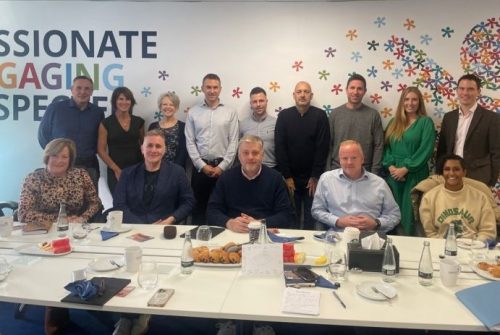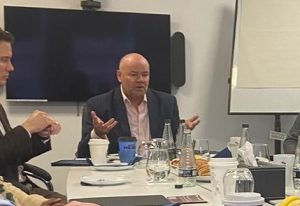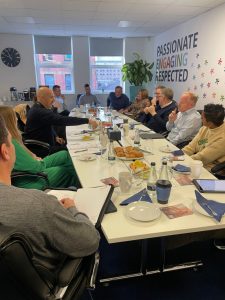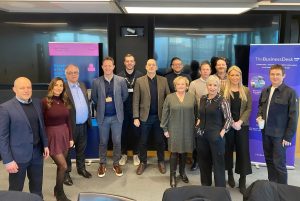A strong positive workplace culture – conclusions from round table on recruitment and retention

It’s never been tougher to recruit, so holding on to good people is vital, and central to that is building a strong positive culture in the workplace.
Jo Sellick from Sellick Partnership opened our round table discussion with that central observation: “We’re looking for people who have got tenacity, a good personality, character, they’re hard working, all that side of it. But finding those talents and skills is quite tough, so it’s important to get your culture right.”

Jo Sellick
With a diverse and engaged group of business owners and senior managers around the table, the discussion dug deep into people’s direct experiences that they felt able to share, and others said they found useful.
Vimla Appadoo from Honey Badger said: “My whole big thing is culture design and being really conscious about the cultures that we’re embedding within an organisation and that often comes from the top.” She painted the picture of the hard-working senior leaders putting in 12 hour days, setting a precedent for what the working culture needs to be, adding: “You might not have any expectation for that of your team but it sets a precedent.”
She also spoke candidly about the COVID pandemic period being “a social awakening for white people” where racial barriers and psychological barriers in the workplace were triggered through the Black Lives Matter movement.
“I will always be that voice in the organisation and in a room to say, well, what are we doing to create psychological safety and our culture is to ensure that we can recruit diversely? How do we ensure we can offer a diverse pool of candidates for any given recruiter?”
She asked how businesses can embed a commitment to diversity within a culture and thus create transparency around what career progression looks like.
Ben Butterfield of Grant Thornton and Stuart Stead from Cowgills are senior leaders in professional services firms and expressed not only how changes are being made when it comes to recruitment, but also some of the setbacks that companies are facing when it comes to diversifying the workforce.
Butterfield said Grant Thornton has, for the first year, shifted to looking for 50% school leavers – non-graduates in other words: “That means we’ve got access to a much, much wider pool, meaning that our recruitment process is all about potential.” And not, he said, what a candidate may have done academically in school.
Similarly, Stead said: “There are loads of great people out there from different backgrounds that we’re just not even engaging with. And they don’t think they’ve got a chance of working in some of these jobs, they aren’t thinking they could be a lawyer or an accountant or financial planner, it’s not even on the radar.” However, he also pointed out the positive impact diversity can bring to businesses, as different studies have repeatedly demonstrated.

Moira O’Shaughnessy, Michael Taylor and Sarah Harkness
Sarah Harkness from IN Accountancy and Moira O’Shaughnessy from FPC, a financial planning firm, spoke of their success in building strong relationships with local schools, aware that being in Stockport and Southport, the young candidate pool is more likely to be from the white and middle class demographics.
“You have to try very hard to extend your reach,” O’Shaughnessy said. “And not just in terms of ethnicity or agenda but now neurodiversity as well. It’s something we’re very aware of. We’re doing training on that for our team, and welcoming applications from those who are neurodiverse.”
Adding her views on what can be done to help employees, Sarah explained: “The thing that I believe has worked really well for us is playing to people’s strengths and recognising what they’re really good at as individuals.”
Carole Spiller, partner at law firm Weightmans, said not only is it unquestionably the right thing to embrace diversity, but it makes the whole outlook of the business that much richer. Speaking of her recent experiences of recruiting from diverse backgrounds she said: “We have a really successful apprenticeship programme, they’re the most impressive kids that you’ve seen, and they’ve all come through different experiences to get there.
“They are making such a difference within our business because they’re bringing that diverse cultural background with them. And they’re opening that up to everybody, so they’ve become the best ambassadors for our firm.”
And John Quinton-Barber from Social added: “We’re in the business of people communications, and if all our colleagues are all white, there’s no diversity. What are our clients getting from that? Not getting diversity of thought, diversity of cultures. And we work with a lot of local communities. And this is why it weighs heavy on me, because we haven’t cracked it.”
Jenny Winstanley from law firm Napthens agreed, she runs an HR advisory platform, AfterAthena, that brings her into contact with hundreds of businesses and sees how they work. She says many clients are moving away from “equality” as a term and moving towards “equity”. “We are giving the resources and opportunity to all, to still achieve the same, as opposed to everyone gets the same,” she said.
She also agreed with Jo Sellick’s point that you can train for skills, but you recruit for attitude and behaviours.
Chris Newman of BNY Mellon also told a story about how a newly promoted colleague took advantage of being in the room to bravely ask questions to the chief financial officer on a call with over 1000 people in attendance, asking about monitoring office attendance.
“She tested him and asked the question that lots of other people weren’t happy to do, which is a really positive example,” he said. Vimla Appadoo added: “when you get a chance to be in the room, you take that chance.”

Chris Hodgen, Vimla Appadoo, Ben Butterfield
The next part of the discussion moved to consider the challenges of flexible working, hybrid working, touchdown spaces and, inevitably, how diverse cultures and people’s real life experiences outside of work need to be considered more holistically. There was even a lively discussion about dress codes and how everyone generally felt liberated by the shift to a more casual and comfortable form of dressing for work.
Ben Butterfield reported that Grant Thornton’s policy is “dress for your day” while others expressed the importance of young people in particular not feeling pressured to dress up. Jenny Winstanley urged people to be mindful of how they communicate rules to staff, explaining that some firms will send a visual presentation to the workforce, offering imagery to aid neurodiverse employees “because they’ll interpret information in a different way.”
While some people in the room spoke about dressing one way if they’re meeting clients and another if they’re not, Chris Newman asked: “Would you feel comfortable walking your clients around your ground floor? Because it sounds like there’s a struggle between one thing for clients and one for yourself – that’s the problem.”
On the wider flexibility point John Quinton-Barber, founder of Social, who was to celebrate his company’s 10th birthday that night, said he has a core value in the business – “life happens” and being there for colleagues.
For Ian MacArthur of the Greater Manchester Good Employment Charter, his experience shows the values that underpin the charter – fairness, flexibility, and a real living wage – have contributed to the process that has really shone a light on working practices.
“Now we’ve just got to get our minds around that we need to think about how we design work moving forward.” He suggested businesses may be missing out on talent that gave up work during the pandemic and are now still at home looking after families. These are also the people that could have work designed to accommodate and include them.
Others had their own experiences to share.
Jenny Winstanley said: “Everyone knows that they need to move towards an agile working policy. Leaders still have a mindset, though, that if you can’t see someone working, they’re not working. Despite the outward facing ‘we support this’.”
Moira O’Shaughnessy added: “We left it to the team to decide what our working policy would be, we didn’t have a mandate of anything at all. And it ended up that different teams are working differently. Some are there all the time, that’s a preference. I think this is going to take permanent effort, it’s not something we’re going to just fix, it’s going to be a constant effort to get that engagement.”
Chris Hodgen, managing director at Absolute Agency, pointed out that different teams within a business might have variable needs and requirements suited to their style: “The digital team will want to work from home all day long every day, if they possibly can. Our design team is very much a collaborative experience. It’s all about working together on things. They are in the studio five days a week, because they work off each other really well.”
Offering the recruiter’s perspective, John Thistlethwaite, from Sellick Partnership, said: “We’re finding that when we’re trying to recruit companies that have a five day a week policy, it’s just not working for candidates.
“Candidates are telling us that they would go in work five days a week but because they’re not being offered that flexibility and the option to have a couple of days from home, they won’t join that business.”
Following the roundtable discussion, Jonathan Moss, Senior Business Manager at Sellick Partnership said: “This was an extremely productive, inclusive and collaborative meeting of minds. Not only has it given us tangible and constructive ideas for Sellick Partnership as an employer, but also for us as recruiters.
“We can always improve on our practices and be better at what we do, and that’s what this session was really all about.”









